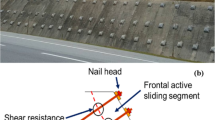Abstract
Prestressed soil-nail system has two reinforcing components: steel bar and PC strands. The steel bar with relatively less elongation yields earlier than PC strands. Thus, yield displacements of these two components should be matched to maximize the design load (capacity) of prestressed soil-nail. To achieve this, PC strands need to be prestressed before applying pullout load. In this study, load transfer mechanisms of soil-nail and prestressed soil-nail were determined based on skin friction theory and load transfer theory. The load transfer was derived analytically based on the assumption that skin friction at the interface was fully mobilized. It was then compared with results from field pullout tests performed to identify in-situ load transfer mechanism. Additionally, optimum prestress level required to maximize the pullout loading capacity was evaluated and compared with those obtained from field tests.
Similar content being viewed by others
References
Alireza, A., Mahdi, B., and Mehran, J. (2014). “Numerical modeling of soil nail walls considering Mohr Coulomb, hardening soil and hardening soil with small-strain stiffness effect models.” Geomechanics and Engineering, Vol. 6, No. 4, pp. 391–401, DOI: https://doi.org/10.12989/gae.2014.6.4.391.
Hobst, I. L. and Zajic, I. J. (1983). Anchoring in rock and soil (2nd Ed.), Elsevier Scientific Publishing, Amsterdam, Netherlands.
Ingold, T. S. (1982). Reinforced earth, Thomas Telford Ltd, London, UK.
Kim, H. T., Kang, I. K., Park, S. W., Koh, Y. I., and Kwon, Y. H. (1999). “Stability analysis and reliability of the pretensioned soil-nail system.” Journal of the Korean Geotechnical Society, Vol. 15, No. 2, pp. 105–127 (in Korean).
Liang, Y. R. and Feng, Y. X. (2002). “Development and application of anchor-soil interface models.” Soils Foundations, Vol. 42, No. 2, pp. 59–70, DOI: https://doi.org/10.3208/sandf.42.2_59.
Milligan, G. W. E. and Tei, K. (1998). “The pull-out resistance of model soil-nails.” Soils Foundations, Vol 38, No. 2, pp. 179–190, DOI: https://doi.org/10.3208/sandf.38.2_179.
O’Rourke, T. D., Druschel, S. J., and Netravali, A. N. (1990). “Shear strength characteristics of sand-polymer interface.” Journal of Geotechnical Engineering, Vol. 116, No. 3, pp. 451–469, DOI: https://doi.org/10.1061/(ASCE)0733-9410(1990)116:3(451).
Park, S. S., Kim, H. T., and Choi, Y. G. (2004). “Stability analysis and design of the pretension soil-nail system.” Journal of the Korean Geotechnical Society, Vol. 20, No. 7, pp. 197–206 (in Korean).
Plumelle, C. (1979). Etude expérimentale du comportment des tirants d’ancrage, PhD Dissertation, Université Paris IV, Paris, France (in French).
Seo, H. J., Choi, H. S., and Lee, I. M. (2016). “Document numerical and experimental investigation of pillar reinforcement with pressurized grouting and pre-stress.” Tunnelling and Underground Space Technology, Vol. 54, pp. 135–144, DOI: https://doi.org/10.1016/j.tust.2015.10.018.
Seo, H. J., Choi, H. S., Lee, K. H., Bae, G. J., and Lee, I. M. (2014). “Pillar-reinforcement technology beneath existing structures: Small-scale model tests.” KSCE Journal of Civil Engineering, Vol. 18, No. 3, pp. 819–826, DOI: https://doi.org/10.1007/s12205-014-1392-3.
Seo, H. J., Jeong, K. H., Choi, H. S., and Lee, I. M. (2012). “Pullout resistance increase of soil-nail induced by pressurized grouting.” Journal of Geotechnical and Geoenvironmental Engineering, Vol. 138, No. 5, pp. 604–613, DOI: https://doi.org/10.1061/(ASCE)GT.1943-5606.0000622.
Seo, H. J., Kim, H. R., Jeong, N. S., Shin, Y. J., and Lee, I. M. (2011). “Behavior of hybrid system of soil-nailing and compression anchor.” 14th Asian Regional Conference on Soil Mechanics and Geotechnical Engineering, Hong Kong, China.
Tan, S. A., Ooi, P. H., Park, T. S., and Cheang, W. L. (2008). “Rapid pullout test of soil-nail.” Journal of Geotechnical and Geoenvironmental Engineering, Vol. 134, No. 9, pp. 1327–1338, DOI: https://doi.org/10.1061/(ASCE)1090-0241(2008)134:9(1327).
Wang, H., Cheng, J., Guo, Y., and Gao, X. (2016). “Failure mechanism of soil nail-prestressed anchor composite retaining structure.” Geotechnical and Geological Engineering, Vol. 34, No. 6, pp. 1889–1898.
Wang, Z. and Richwien, W. (2002). “A study of soil-reinforcement interface friction.” Journal of Geotechnical and Geoenvironmental Engineering, Vol. 128, No. 1, pp. 92–94, DOI: https://doi.org/10.1061/(ASCE)1090-0241(2002)128:1(92).
Zhang, C. C., Xu, Q., Zhu, H. H., Shi, B., and Yin, J. H. (2014). “Evaluations of load-deformation behavior of soil nail using hyperbolic pullout model.” Geomechanics and Engineering, Vol. 6, No. 3, pp. 277–292, DOI: https://doi.org/10.12989/gae.2014.6.3.277.
Zhao, Y. L., Zhang, H. B., Zhu, Q. P., and Chen, D. (2013). “Simulation analysis on tension and deformation of composite soil nailing.” Applied Mechanics and Materials, Vol. 405–408, pp. 182–186.
Acknowledgements
This research was supported by a grant (Project number: 18SCIP-B066321-06 (Development of Key Subsea Tunneling Technology)) from the Infrastructure and Transportation Technology Promotion Research Program funded by the Ministry of Land, Infrastructure and Transport of the Korean government. The first author was supported by a grant (No. 2013R1A6A3A03059659) of the Basic Science Research Program through the National Research Foundation of Korea (NRF) funded by the Ministry of Education.
Author information
Authors and Affiliations
Corresponding author
Rights and permissions
About this article
Cite this article
Seo, H., Lee, IM., Ryu, YM. et al. Mechanical Behavior of Hybrid Soil Nail-Anchor System. KSCE J Civ Eng 23, 4201–4211 (2019). https://doi.org/10.1007/s12205-019-2268-3
Received:
Accepted:
Published:
Issue Date:
DOI: https://doi.org/10.1007/s12205-019-2268-3




